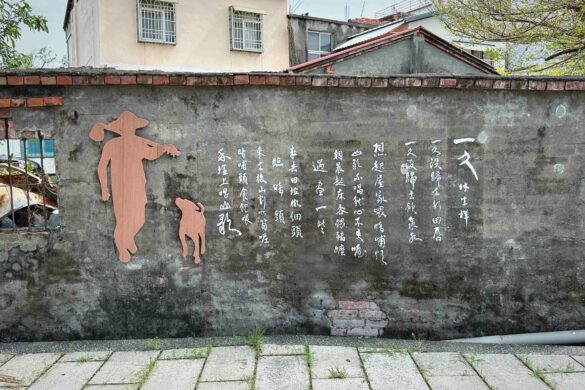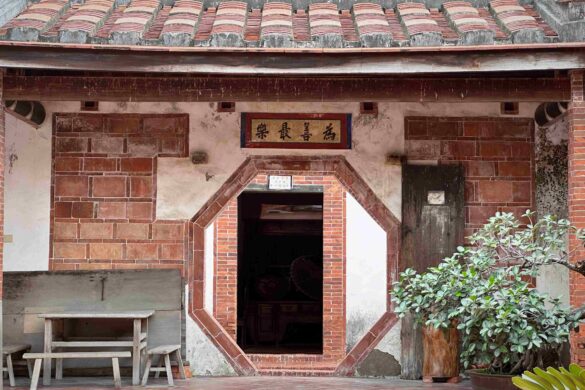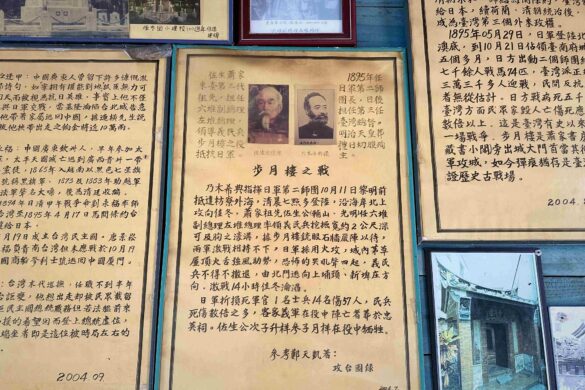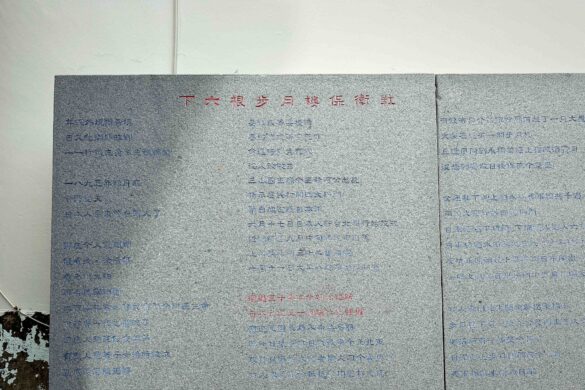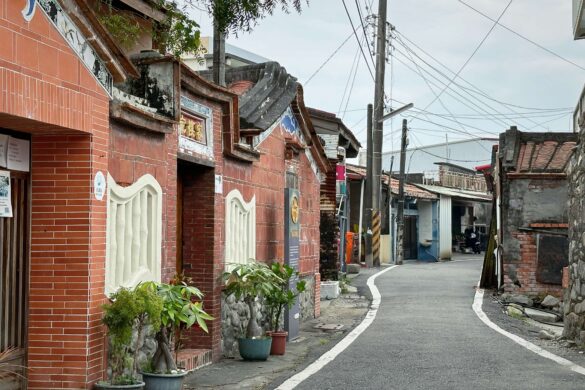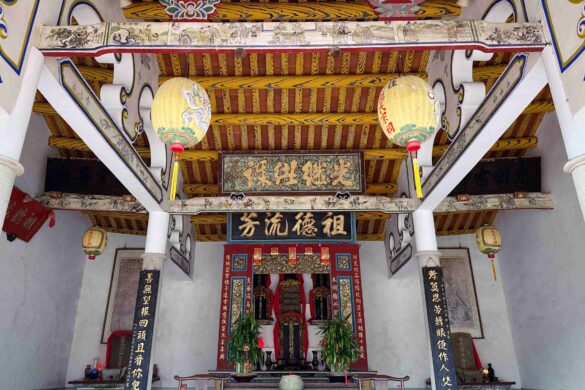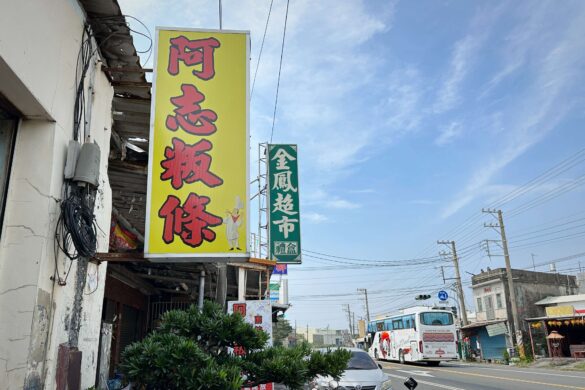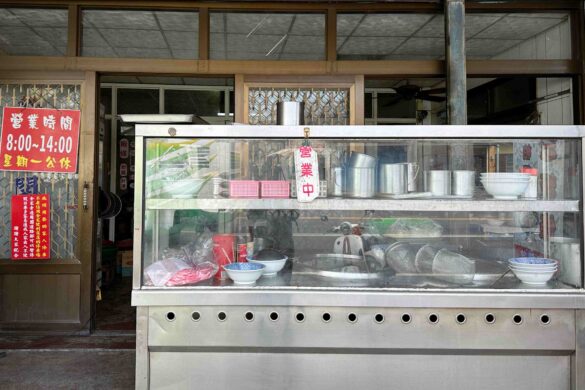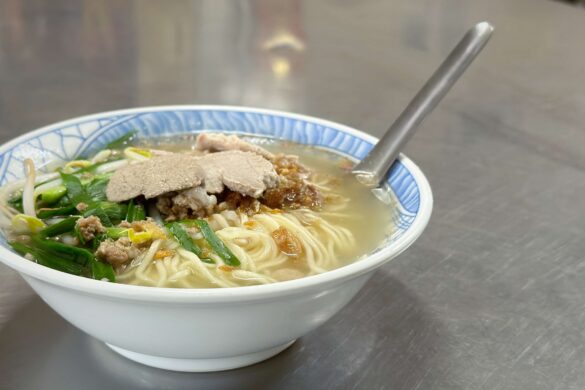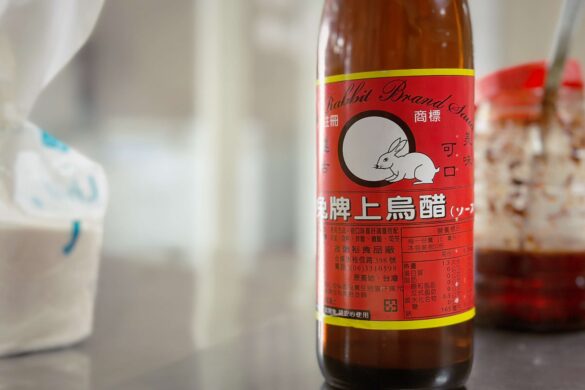After getting off at Jiadong Railway Station, our first stop was the famous Ah-Zhi Ban-Tiao (rice noodles). With our appetites satisfied, we continued forward, ready to explore this “living museum.”
Among the Liudui Hakka settlements in Pingtung, Jiadong once thrived economically and demographically thanks to its advantageous harbor location. Early Hakka settlers, who prospered through trade, gradually built grand residences and ancestral halls on this land. As a result, Jiadong now preserves the largest number of old houses and historic sites in Taiwan, many of them in remarkably good condition. What’s more, they are clustered within walking distance—less than a kilometer apart—making it easy to explore these cultural treasures on foot. Highlights include the Yang Ancestral Hall, the Xiao Family Residence, the Zhang Family Trading House, the West Gate, and the Respect-for-Characters Pavilion. Each site feels like a vivid textbook of history. In the cool autumn breeze, it’s the perfect place to take a leisurely family stroll.
Contents
◦ Pingtung Travel Guide
01|Transportation in Pingtung
🚄 Taiwan High Speed Rail
🚗 Car Rentals - Save Up to 10%
🚢 Xiaoliuqiu - Donggang Ferry Ticket
02|Popular Attractions in Pingtung
🎫 National Museum of Marine Biology and Aquarium Ticket
🎫 Sleepover Experience at National Museum of Marine Biology and Aquarium
🎫 Paradise of Deer Ticket in Kenting
🎫 Tickets for Kenting Luyu Island Capybara Ecological Park
🎫 Shuangliu National Forest Recreation Area Tickets
03|Things To Do in Pingtung
🚣🏻 Stand Up Paddleboarding Experience in Kenting
🤿 Water Activities at Kenting South Bay
🤿 Liuqiu Snorkeling Tour by Bear Diving in Pingtung
🏔️ Alangyi Hostoric Trail Hiking Day Tour
◦ The Past of Jiadong
Jiadong was once the homeland of the Makatao people of the Pingpu indigenous group, specifically the Kateng community. In the early days of settlement, the area was covered with Formosan ebony trees (called Jiadong in Taiwanese), which gave rise to its former name, “Jiadong -jiao.” During the Japanese colonial period, it was renamed to the present-day “Jiadong.”
Located in the “Left Liudui” area of the Pingtung Hakka settlements, Jiadong is predominantly home to Hakka people, followed by Hoklo (Minnan) residents. Its greatest charm lies in the unparalleled preservation of traditional houses and heritage sites—truly earning its reputation as a “living museum.”
◦ Attractions in Jiadong
01|Poet’s Trail
Born in Jiadong, the “poet-doctor” Tseng Gui-hai once lived in a house along the town’s old street. Inspired by his legacy, the Jiadong Cultural and Historical Association invited local residents to lend their walls and windows, transforming them into canvases for poetry.
Here, visitors can encounter the works of renowned Liudui poets such as Zhong Li-he, Tseng Gui-hai, and Lin Sheng-xiang. Among them, Chen Ning-gui’s poem Together (Gong-yang)—inscribed on a weathered brick wall—left a particularly lasting impression on me.
Poet’s Trail No. 19-30, Donggen Rd., Jiadong Township, Pingtung
02|Old House of Siiao Family
Thanks to its advantageous harbor, Jiadong once experienced a period of economic and demographic prosperity. Wealthy pioneers such as the Siiao, Lai, Zhang, and Yang families amassed their fortunes through trade and gradually built grand residences and ancestral halls throughout the town. Among them, the Siiao family was one of the most prominent lineages. With a flourishing clan and many accomplished descendants, their residence was hailed as a “prime dragon’s den” in feng shui terms. To this day, their traditional compound, the Bu-yue (Moon-Stepping) Tower, the Western-style mansion, and even their rice mill have been preserved.
The scale of the Siiao ancestral home is truly impressive: over fifty rooms capable of housing nearly a hundred residents, making it the only five-courtyard Hakka compound of its kind in Taiwan. Walking inside, you may notice laundry hanging out to dry—a quiet reminder that this is not a lifeless relic frozen in time, but a living home. For me, this everyday vitality is the most beautiful form of heritage preservation.
Old House of Siiao Family Opening Hours: 0900-1200, 1400-1700, closed on Monday. No. 150, Gouzhu Rd., Jiadong Township, Pingtung
03|The Respect Words Pavilion
Not far from the Old House of Siiao Family stands the Respect Words Pavilion, also known as the Sacred Traces Pavilion. Built in 1850, it has a history of more than 170 years and remains remarkably well preserved. In the agrarian past, the Hakka people held written words in deep reverence. Any paper bearing characters could not simply be discarded; instead, it had to be sent to the pavilion and burned as an act of respect.
Shaped like a pagoda, the pavilion has two distinct levels: the first was used for burning written paper, while the second enshrines revered figures—Cangjie, the legendary inventor of Chinese characters; Wenchang Dijun, the god of culture and literature; and Wenkui Dijun, the patron of scholarly success. Together, they reflect the community’s profound respect for knowledge and the written word.
The Respect Words Pavilion Diagonally across from the Old House of Siiao Family
04|Bu Yue Building
The Bu Yue Building once served as the Siiao family’s study and library. On the ridgeline of its gatehouse, delicate carvings of egrets and lotuses symbolize aspirations of success in the imperial examinations, while motifs of qilin and magpies add blessings of peace and good fortune.
The outer walls, joined with dense plantings of thorny bamboo, formed a private gate akin to a fortress—an unmistakable sign of the Siiao family’s influence and power in their heyday. Today, within the Old House of Siiao Family, historical records of the “Battle of Bu-yue Building,” fought in resistance against Japanese forces, are still preserved.
Bu Yue Building No. 91, Qinan Rd., Jiadong Township, Pingtung
05|Zhang Family Trading House
Built in the 1910s, the Zhang Family Trading House was the only two-story red-brick building in Jiadong at the time. It also served as a general store where locals purchased daily necessities. By the 1950s, as television began entering people’s lives, the shopfront became a lively gathering spot each evening. Villagers crowded together to watch Taiwanese opera and baseball broadcasts, their cheers echoing through the narrow lanes.
Over the decades, the brick structure gradually deteriorated. It wasn’t until 2011, thanks to the efforts of Dr. Tseng Gui-hai—who rallied support from the Jiadong Cultural and Historical Association and many others—that the Trading House was revived. Today, its second floor hosts exhibitions of poetry and artworks related to Jiadong, allowing the historic residence to continue telling the stories of this small town.
Zhang Family Trading House Opening Hours: 0900-1125, 1400-1700, closed on Monday to Friday. No. 1, Xibian Rd., Jiadong Township, Pingtung
06|Yang Family Ancestral Hall
One of the main reasons I was drawn to Jiadong was to see something I had never encountered elsewhere—the Taiji Liangyi Pond! Completed in 1923 as part of the Yang Family Ancestral Hall, this unique pond integrates feng shui principles into its design, symbolizing prosperity through water and the endless cycle of life. Up close, the pond is carpeted with lotus leaves, with small fish and tadpoles darting about. If you visit in June or July, you’ll be treated to an even more spectacular view when the lotus flowers are in full bloom.
The ancestral hall itself is equally captivating, featuring beautifully preserved traditional craftsmanship such as swallowtail roof ridges, glazed tiles, and intricate Koji pottery. It was so enchanting that I found it hard to leave.
Yang Family Ancestral Hall Opening Hours: 0800-1800 No. 138, Jiaxing Rd., Jiadong Township, Pingtung
07|Jiadong Shinto Shrine
Located in a more remote part of town, the Jiadong Shinto Shrine was built during the Japanese colonial period as part of the “one shrine per village” policy. It was consecrated in 1936 (Showa 11) and classified as a mukakusha—a shrine not officially ranked within the Shinto hierarchy.
After World War II, most shrines in Taiwan were either destroyed or repurposed. Today, the shrine’s approach has become an ordinary roadway, and residential houses have been built nearby. Still, remnants such as the torii gate, sacred bridge, and stone lanterns remain as silent traces of its past.
Jiadong Shinto Shrine No. 1, Daping Rd., Jiadong Township, Pingtung
◦ Restaurants and Snacks in Jiajung
01|Ah-Zhi Rice Noodles
With over 70 years of history and three generations of family tradition, Ah-Zhi Rice Noodles insists on using aged rice to enhance the chewy texture of its handmade noodles. Thanks to its coastal location, the shop not only preserves the Hakka specialty of crispy fried shallots but also offers a unique tuna meat sauce in place of the traditional pork, giving the broth a subtle seafood sweetness and depth of flavor.
On the table, a bottle of White Rabbit brand black vinegar adds the finishing touch. This time-honored vinegar from Tainan is mellow and smooth, with a bright, slightly tangy flavor and a hint of saltiness—making it the seasoning of choice for many connoisseurs.
Ah-Zhi Rice Noodles Opening Hours: 0800-1400, closed on Monday. No. 97-6, Jiahe Rd., Jiadong Township, Pingtung
◦ Flying Over Taiwan
*All aerial photography operations are conducted within legal airspace. During flight, regulations stipulated by the Civil Aviation Law are strictly followed, maintaining the required distance from buildings and crowds. Zooming and post-production techniques are used to ensure compliance, making the flights fully legal.
*Anyone citing these images and text must provide proper attribution. Unauthorized or illegal use of the images and text is prohibited and may result in legal liability.
◦ Other Areas in Pingtung
➤ Neipu | What’s the Connection Between Han Yu and Neipu?
➤ Hengchun | Hengchun Chiang Ku Festival
➤ Shinyuan | The Battle Between the Carp Spirit and Lin Banxian

